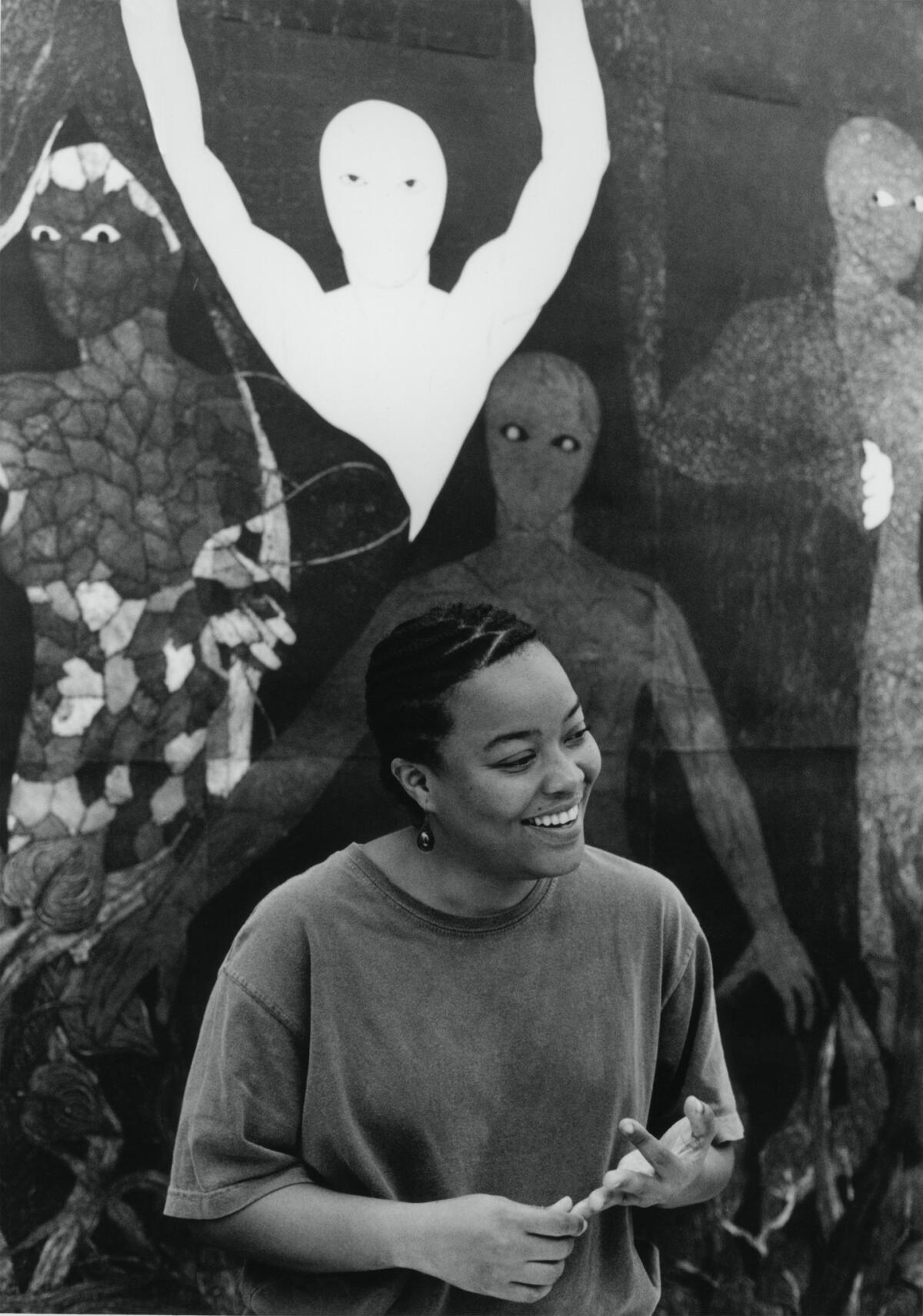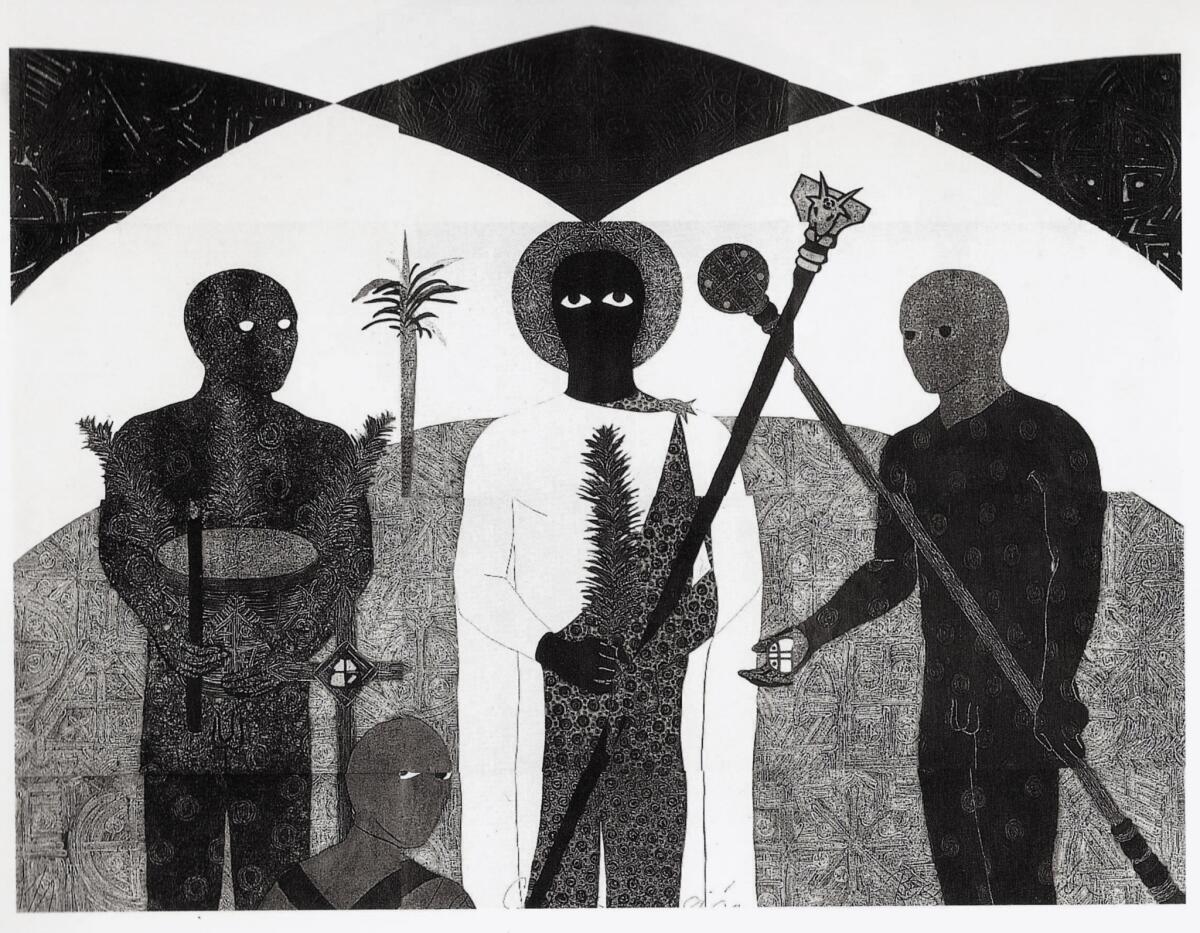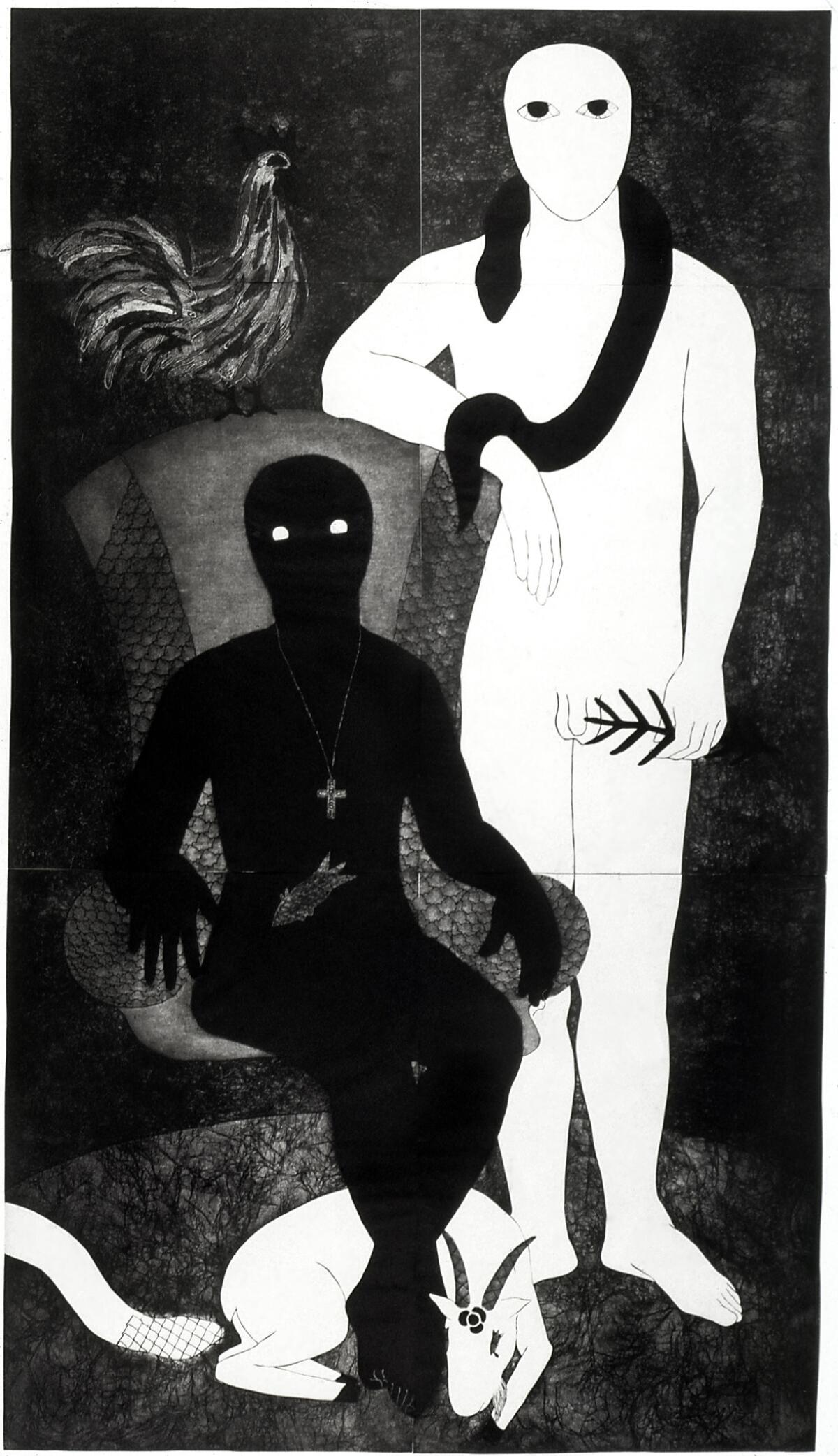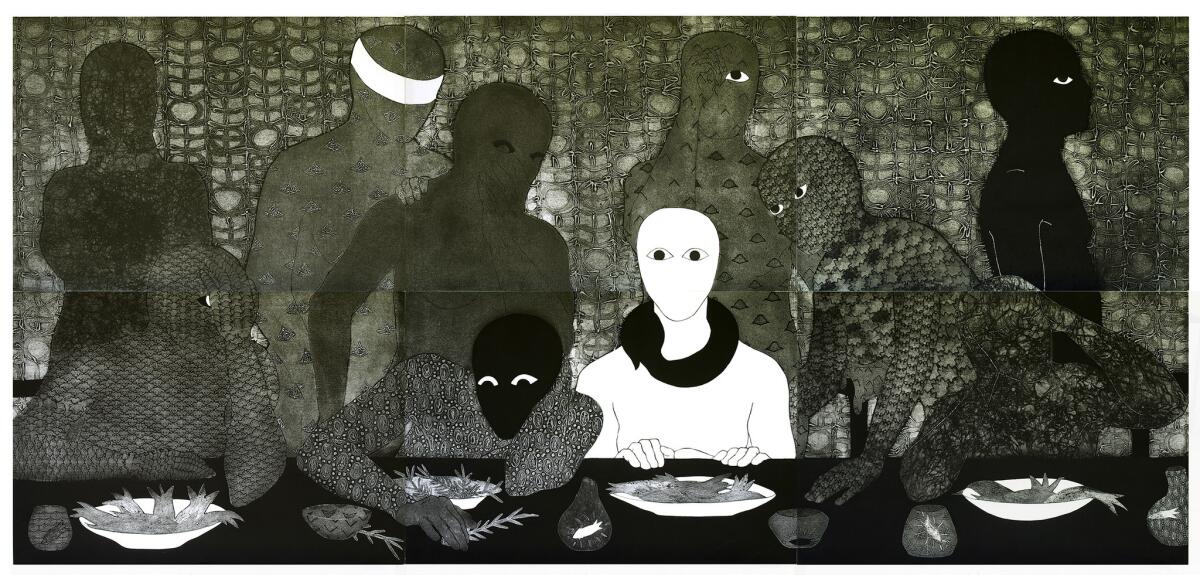The late Cuban artist Belkis Ayón’s mysterious world unfurls at the Fowler Museum

The late Cuban printmaker Belkis Ayón mysteriously took her own life in 1999. The Fowler Museum will open the first Ayón retrospective in the U.S. on Oct. 2. Here, in a silent video shot in Cuba a year before her death, the artist is shown making
- Share via
The moment is shrouded in secrets.
Cuban artist Belkis Ayón’s family home sits on a quiet street of central Havana, the charm of the house belying the mysteries of her death. White shutters open to leafy banana trees and crowing roosters. A warm, mango-scented breeze wafts through the central hallway, which is lined with the artist’s storied prints.
But a certain heaviness also flows through the house. In 1999, at just 32, one of the most important Cuban artists of the decade shot herself in the head with her father’s gun. Ayón didn’t leave a suicide note, but she did leave behind a prolific body of work that explores the dark mythology of Abakuá, an all-male, Afro-Cuban secret society not unlike the Masons.
Today, three generations of Ayón’s family live here, looking after her oeuvre. In the living room, Ayón’s sister and niece talk about the enormous unframed prints that are nearly as tall as the wall they’re tacked to. The haunting black-and-white artworks will travel for an exhibition at the Fowler Museum at UCLA opening Oct. 2; but on this humid May afternoon, the works are on view for visitors to the house who seem equally drawn to and frightened by the imagery. The prints are teeming with graphic renderings of snakes and fish and goats; dark silhouettes and ghostly-white figures with oblong heads and empty, almond-shaped eyes take part in Abakuá rites and rituals.
“The work is powerful but can be scary too,” Ayón’s older sister, Katia Ayón Manso, says in Spanish through a translator. “The clean precision in the lines and the high level of her work reveal the mastery she reached in printmaking.”
Ayón was a pioneer of large-scale printmaking and collography, a complex, labor-intensive technique using intricately collaged cardboard plates. She rose in the contemporary art world in the 1990s, a period of dire poverty in Cuba after the fall of the Soviet Union, when supplies for artists were hard to come by. Her innovative, multi-paneled works boldly mine the insular brotherhood of Abakuá through a distinctly feminist lens and offer veiled commentary on contemporary Cuban politics and culture.
Our intention is to keep Belkis’ legacy alive.
— The artist’s sister, Katia Ayón Manso

Forty-three of Ayón’s works — from when she was in high school to the year she died — will be on view in the Fowler exhibition “Nkame: A Retrospective of Cuban Printmaker Belkis Ayón.” Although the artist’s work is included in the collections of the Museum of Contemporary Art in L.A. and the Museum of Modern Art in New York, and even though she has shown in American art galleries ever since her first U.S. exhibition at L.A.’s Couturier Gallery in 1998, the Fowler’s “Nkame” is the first U.S. museum retrospective of her work.
“It’s an important moment,” Fowler Director Marla Berns says. “At this time of reopening of diplomatic relations between America and Cuba, it’s important for people to learn more about Cuban culture and artists of great talent that they may never have heard of before because of the limited access we’ve had to Cuba. A larger American audience will now become aware of Belkis Ayón, both as an Afro-Cuban artist and one of the most accomplished contemporary printmakers anywhere.”
The Fowler exhibition is something Ayón’s niece, Yadira Leyva Ayón, never could have imagined even just a few years ago. As she gives a tour of the house, where the chirping of parakeets in brightly colored cages fills a courtyard off the kitchen, Leyva Ayón says improved U.S.-Cuba relations helped the exhibition to come together relatively easily.
“Now, it’s like a whole world of possibilities in front of us,” she says.
Ayón’s 74-year-old mother, a slip of a woman barely 5 feet tall, shuffles by in purple slippers and a bright smile, then disappears into her bedroom to watch Cuban game shows on a static-y black-and-white TV. Nearly every patch of white wall space here is covered with Ayón’s works, but they’re just the tip of the iceberg — the artist worked fast and focused, her family says, creating more than 200 editions, each print consisting of up to 18 individually made panels.

After Ayón’s death, her sister, Ayón Manso, gave up her career as a doctor to look after the artworks left behind. Conservation of the paper works, in a humid country where temperature-controlled, museum-grade storage isn’t widely available, has been a constant battle. But the family does the best it can, storing the prints in custom-built, cedar wood flat files stuffed with mothballs and moisture absorbers, providing as much protection as in some museums in Cuba.
Ayón Manso misses practicing medicine, she says, “but our intention is to keep Belkis’ legacy alive.”
At this, Leyva Ayón surveys her aunt’s works on the walls. Her eyes well with tears as she recalls the tragic day Ayón died.
“She shot herself in my grandmother’s [former] house, in the bathroom,” Leyva Ayón says. “When they returned from the hospital, my grandmother had her shoes covered in blood. I realized something very bad had happened with my aunt.”
Leyva Ayón takes a moment to compose herself.
“It’s so difficult for us to talk about, it was shocking for everyone,” she says, adding that her aunt was known for her big laugh. “She had a big ha-ha mouth. Super-noisy.”
Why the artist with the cheery demeanor and boisterous laugh took her own life remains a mystery.
“She was like a light bulb who lit up a room,” says L.A. gallerist Darrel Couturier, who spoke to Ayón on the phone just two days before she died. “We made arrangements to meet in Philadelphia, and she sounded great and fine and happy. She was going to begin doing work in color again at the Brandywine Graphic Workshop there. If she was depressed, she never showed that side of herself.”
Even as a child, Ayón was bursting with energy and cheer — so much so that her mother enrolled a 7-year-old Belkis in a painting workshop in Old Havana to calm her. She took to art immediately. In high school, at San Alejandro Academy of Fine Arts, Ayón became fascinated by Abakuá. She dedicated her work to the narrative of the secret society, which Nigerian slaves brought to Cuba and which is now recognized as a religion in the country.
Ayón related to one of the central figures in the Abakuá myths, the strong Princess Sikan, whom she saw as her alter ego. But whereas Sikan was killed for revealing secrets, Ayón kept Sikan alive and thriving in her artworks, a survivor.
Ayón boldly experimented in her art. Shortly after graduating from Havana’s distinguished Instituto Superior de Arte in ’91, she switched to working only in black, white and gray largely because the stark palette heightened the drama in her prints. She used a variety of materials on each printing surface, or matrix — soft paper, cardboard, sandpaper, vegetable peelings, acrylic paint — that left gradations of ink. She painted over parts of the matrix to create raised surfaces and carved into other areas, creating grooves to trap the ink. Then she ran the matrix and paper through a hand-cranked printing press.

The result, a reverse impression of the matrix, was a rich tapestry of crackles and swirls, floral patterns, circular and geometric shapes, along with human and animal forms. All were layered on top of an enigmatic, storied narrative brimming with crosses, halos and other religious iconography, as well as art history references.
Eventually Ayón headed up the printmaking department at ISA, and she served as the president of the artists division of UNEAC, the national union for artists and writers. In 1993 she took part in the Venice Biennale and the same year was awarded the international prize at the International Graphics Biennale in Maastricht, the Netherlands.
“Nkame,” organized by the Belkis Ayón Estate and Ayón Manso with the Fowler Museum, was guest-curated by Havana-based curator Cristina Vives-Figueroa. The show is divided into five sections grouped around the developmental stages of Belkis’ work, following an intensified interest in Abakuá.
The introductory section in the show spotlights one of Ayón’s signature works, the six-panel “La Cena,” (“The Supper”). In the work, Ayón has replaced the Jesus figure at the center of the table with Sikan, glowing in all white, and most of the male apostles are replaced by women. The original matrix it was made from hangs opposite it.

The second section focuses on the artist’s early work, the third on the role of Sikan in Abakuá, the fourth on her largest-format prints and the fifth on her latest work, medium-sized circular prints from 1998 that are more self-referential.
Ayón’s family says it hopes to one day open a proper museum in Havana of Ayón’s work and, with the ongoing opening of Cuba, to continue to organize international retrospectives, showing the work as far and wide as possible.
Presenting “Nkame,” which means “greeting” or “praise” in the language of Abakuá, in Los Angeles is the first step.
“It’s like a [tribute],” Leyva Ayón says of the exhibition.
“Here in Cuba, we always keep hope for everything,” she says. “And we have hope that now, so many people will see Belkis’ work. It’s important for our culture and our family. She was a very outstanding artist and person. And this way, we keep her alive.”
------------
‘Nkame: A Retrospective of Cuban Printmaker Belkis Ayón’
Where: Fowler Museum at UCLA, 308 Charles E. Young Drive North, Los Angeles
When: Oct. 2 to Feb. 12; museum is open noon to 8 p.m. Wednesdays, noon to 5 p.m. Thursdays-Sundays
Admission: Free
Information: (310) 825-4361, www.fowler.ucla.edu
Follow me on Twitter: @debvankin
ALSO:
Doug Aitken's 'Electric Earth' will shake the MOCA landscape
The Broad announces its first visiting special exhibit: 'Yayoi Kusama: Infinity Mirrors'
In Havana, following a USC museum director in search of great Cuban art
The biggest entertainment stories
Get our big stories about Hollywood, film, television, music, arts, culture and more right in your inbox as soon as they publish.
You may occasionally receive promotional content from the Los Angeles Times.








